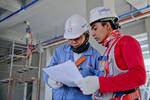
29 May 8 Ways to Promote Health and Safety in the Workplace
The importance of health and safety in the workplace cannot be overstated. A safe workplace not only protects employees from injury and illness but also contributes to overall productivity and job satisfaction. This article explores eight critical strategies to foster a culture of safety and well-being within any organization. From establishing a strong foundation of safety practices to embracing ongoing education and risk management, we’ll guide you through effective measures to ensure your workplace remains a secure place for everyone. Let’s dive in and explore how to make health and safety a top priority in your workplace.
Establish a Culture of Safety
 Creating a culture of safety starts with a commitment from the top. When management leads by example, the message is clear: safety is paramount. This commitment should permeate every level of the organization, encouraging all employees to take responsibility for their safety and that of their colleagues. Regularly communicating about safety goals and celebrating achievements in this area can reinforce its importance.
Creating a culture of safety starts with a commitment from the top. When management leads by example, the message is clear: safety is paramount. This commitment should permeate every level of the organization, encouraging all employees to take responsibility for their safety and that of their colleagues. Regularly communicating about safety goals and celebrating achievements in this area can reinforce its importance.
Hire Qualified Health and Safety Professionals
A crucial step in promoting workplace health and safety is hiring the right professionals. These individuals are not just experts in identifying hazards and implementing safety protocols; they are also educators who play a significant role in training employees about safety compliance and best practices. When looking for these specialists, it’s essential to consider their knowledge of current regulations, their ability to engage and educate diverse teams, and their experience in handling health and safety issues across various settings.
Such professionals have expert training and can educate your employees on health assessment techniques within the workplace. Whether you hire these professionals or encourage your existing employees to enroll in online nurse educator programs, you’ll be doing your company a favor. These programs offer comprehensive training in health and safety, equipping participants with the skills needed to make a meaningful impact in workplace safety education.
Ongoing education is the backbone of a robust safety culture. Regular safety training sessions ensure that all employees are up-to-date on the latest safety practices and technologies. These sessions can vary in format, from in-person workshops to online modules, making them accessible and engaging for everyone. Training shouldn’t be a one-size-fits-all approach; instead, it should be tailored to meet the specific needs of different departments and roles within the organization. By making training a continuous process, companies can adapt to new safety challenges and ensure that their employees are always equipped with the knowledge to protect themselves and their coworkers.
Implement a Reporting System
An effective way to detect and mitigate risks before they escalate into serious problems is to implement a comprehensive reporting system. This system should inspire employees to report safety concerns, near misses, and incidents without fear of retribution. An anonymous reporting option can be particularly effective in ensuring that employees feel safe to report issues. Once reported, management must act promptly, investigate reports, and take necessary corrective actions. This not only addresses the immediate concerns but also reinforces the organization’s commitment to safety, promoting a more proactive safety culture.
Conduct Regular Risk Assessments
Keeping the workplace safe starts with knowing what dangers might be lurking. That’s where regular risk assessments come in. Think of these as a safety check-up for your workplace. By regularly looking around and identifying things that could potentially hurt someone, businesses can figure out how to fix these issues before anyone gets hurt. It’s like spotting a spill on the floor before someone slips on it. The key is to not just do this once and forget about it but to keep checking regularly. This way, as new equipment comes in or new tasks are introduced, you’re always one step ahead in keeping everyone safe.
Provide Necessary Safety Equipment
Imagine a firefighter without a fireproof suit or a construction worker without a hard hat. Sounds wrong, doesn’t it? That’s because having the right gear is crucial to staying safe on the job. Every workplace should make sure its employees have whatever equipment they need to protect themselves. This could be as simple as gloves and goggles in a lab or noise-canceling headphones in a noisy factory. It’s not just about having this equipment, though. It’s also crucial to make sure everyone knows how to use it correctly and that it’s always in good condition.
Regular Health and Safety Updates
Things change fast in the world of health and safety. New rules come out, new research finds better ways to stay safe, and new equipment gets introduced. That’s why it’s important for everyone at work to stay in the loop. Regular updates can help with this. Whether it’s a quick email, a notice on the bulletin board, or a chat in a team meeting, keeping everyone informed about the latest in health and safety makes sure that everyone is working from the latest playbook. This way, everyone knows how to keep themselves and their coworkers safe.
Encourage Open Communication
A big part of keeping the workplace safe is making sure everyone feels comfortable talking about safety. This means managers need to listen as much as they talk. When someone points out a safety issue or has a suggestion on how to make things safer, it’s important to take them seriously. This open line of communication helps catch potential problems early and makes everyone feel like they’re a part of keeping the workplace safe. Encouraging this kind of open dialogue shows that safety is a team effort.
Wrapping Up
Promoting health and safety in the workplace is about much more than following a list of rules. It’s about creating an environment where everyone looks out for each other, where safety is part of the culture, and where everyone feels comfortable speaking up. From the top of the organization down, it takes commitment and ongoing effort to maintain this kind of environment. By establishing a culture of safety, hiring the right professionals, keeping everyone trained, and staying vigilant about potential risks, companies can ensure that their most valuable asset—their employees—stays safe and healthy. Remember, a safe workplace is a productive and happy workplace. Let’s all commit to making safety a priority every day.
The information on MedicalResearch.com is provided for educational purposes only, and is in no way intended to diagnose, cure, or treat any medical or other condition.
Some links may be sponsored. Products are not endorsed.
Always seek the advice of your physician or other qualified health and ask your doctor any questions you may have regarding a medical condition. In addition to all other limitations and disclaimers in this agreement, service provider and its third party providers disclaim any liability or loss in connection with the content provided on this website.
Last Updated on July 24, 2024 by Marie Benz MD FAAD
